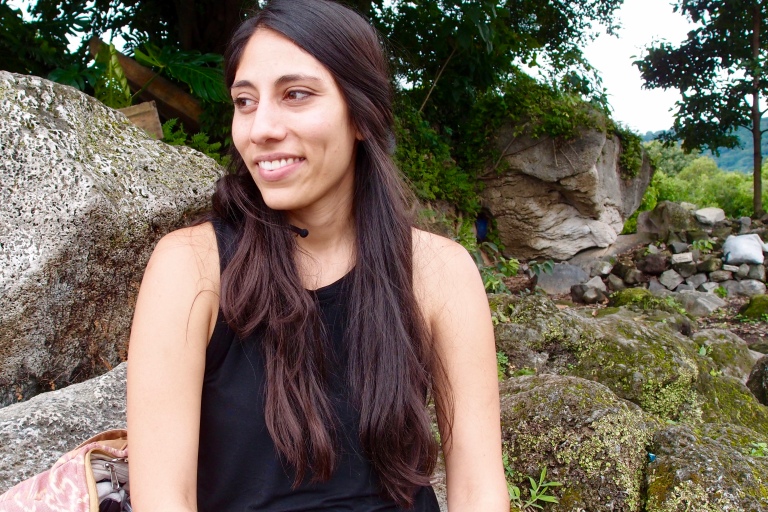It was Saturday morning. I woke up early and tried to get lost from the worn tourist paths in San Pedro. I was trying to find a spot near Lake Atitlán, where I could sit and think in peace. Instead, I found something better: three beautiful girls – Yael (15), Mijal (6) and Martita (4)—that saw me as a friend and shared their morning with me.
***
Outside of the San Pedro paths lined with cafes and tourist shops, there are dirt trails in between small farmed fields growing fruit trees, corn and cabbages, amongst other foods. Wild flowers climb up fences, while yellow birds flutter in between the trees’ leaves. I get lost in the vegetation and find painted wooden boats on the lake’s empty shore. No one is around. There’s a sense of decay surrounding this lake, with abandoned cement structures against a gray sky.
San Marcos was different. Lake Atitlán, enclosed with its three towering volcanoes, was cloaked with mist, resembling a dream. The weather was cold and rainy. In the quiet spot I found on a pier in San Marcos—another town on the lake—I found men and boys fishing for their dinner and speaking solely in Kaqchikel, a Mayan dialect used widely here around the year 900 C.E. Watching these men and boys converse quietly in a language from another time was like stepping through a wormhole. Had their dress been less modern, I would have been witnessing an ancient rite.

Back in San Pedro, I come across horse stables and follow a footpath that leads me to a rocky cove. Here, three sisters are washing clothes and playing in the water. I ask them if I could sit in the rocks above them. They smile and invite me to stay in Spanish, although they whisper to each other in Tz’utujil, yet another Mayan dialect surviving in this region. I thank the universe that I’m also a girl and—as a girl I know this—non-threatening to them, even though I am a stranger that they probably shouldn’t be talking to. Nevertheless, the girls and I become fast friends. Martita, who is 4, asks me if I want to look for snails with her. Together, we climb up and down the rocks finding many snail shells—few live ones—and even pieces of Mayan pottery, a common find near the old Mayan sites of Guatemala.


The oldest, Yael, washes clothes with Mijal, who is 6, and mainly playing with the soap and water. She laughs loudly and jokes, making funny faces and grand expressive gestures. Her energy and Little Mermaid t-shirt makes me think of myself as a child, and we all chat for hours about so many things. I learn their names and ages, and what their parents do (the mother sales at the market and the father owns the horses I saw before). They tell me what they like to do. Martita loves horses. They tell me about their other sister, Lea, who is 12, and cleaning the house all by herself. They make up stories about monsters and sharks in the lake. They learn things about me, too, and I ask if I can take their picture, mainly because I want to remember this moment, and this feeling of real, high-quality connection. To me, traveling means little without this opportunity to spend time and connect, and I am thankful that I can actually speak to these girls. This is a privilege I didn’t get with the people I encountered in my travels through Thailand, Cambodia and Vietnam.
Martita asks to use my camera, and I show her how to keep her tiny fingers away from the lens. She takes hundreds of shots of me and her sisters, and of the hair style she created for me. Looking back at the photos from this day, these girls with mythical warrior names, seem to be precisely that: beautiful souls, already strong and independent, navigating through their world.




In our world, women and girls are so often unsung—inconspicuously fulfilling daily chores, like cleaning a home or washing clothes. In development, we call this unpaid work “reproductive” labor, which is often unseen and uncelebrated in our capitalist system, but so necessary to keep society going. Taking care of children, of the elderly, of the sick, cleaning, cooking, mending, tending – all of these things are necessary to keep life going. At worst, (primarily) women and girls are coerced into, abused and exploited while fulfilling domestic work. At best, so few of those that do these tasks get the proper appreciation and recognition for the hard work they accomplish – or all they give up to do it – every single day. (This statement also includes the men that do this work.)
There are so many of these girls and women—mothers, daughters, sisters, grandmothers—around the world, and in these photos, I attempted to capture their vigor and boundless energy. This makes me think they are guerreras—girl warriors— that nothing and no one could stop.
As a woman I know this: our patriarchal society does not favor us. Pretty much everywhere, we don’t get it easy. There are subtle comments, micro-aggressions and explicit behaviors that put women down. I experience it nearly every day with men cat-calling me, with the commentary on the way I look or behave by both men and women, the inappropriate looks and groping, my general awareness that almost anywhere where I’m without male accompaniment, I’m exposed and vulnerable. This is true even if I’m with a group of women. In certain parts of the world, women need entirely different spaces to be in at peace. We are not equal. We are not free to just be people. Not yet. Still, with strength and joy, we shine and carry on.



(Thanks, Fer, for helping me see the story behind these photos with your post-apocalyptic warrior-princess perspective on the above. ♥)

Beautiful shots, Melanie!
Beautiful post!